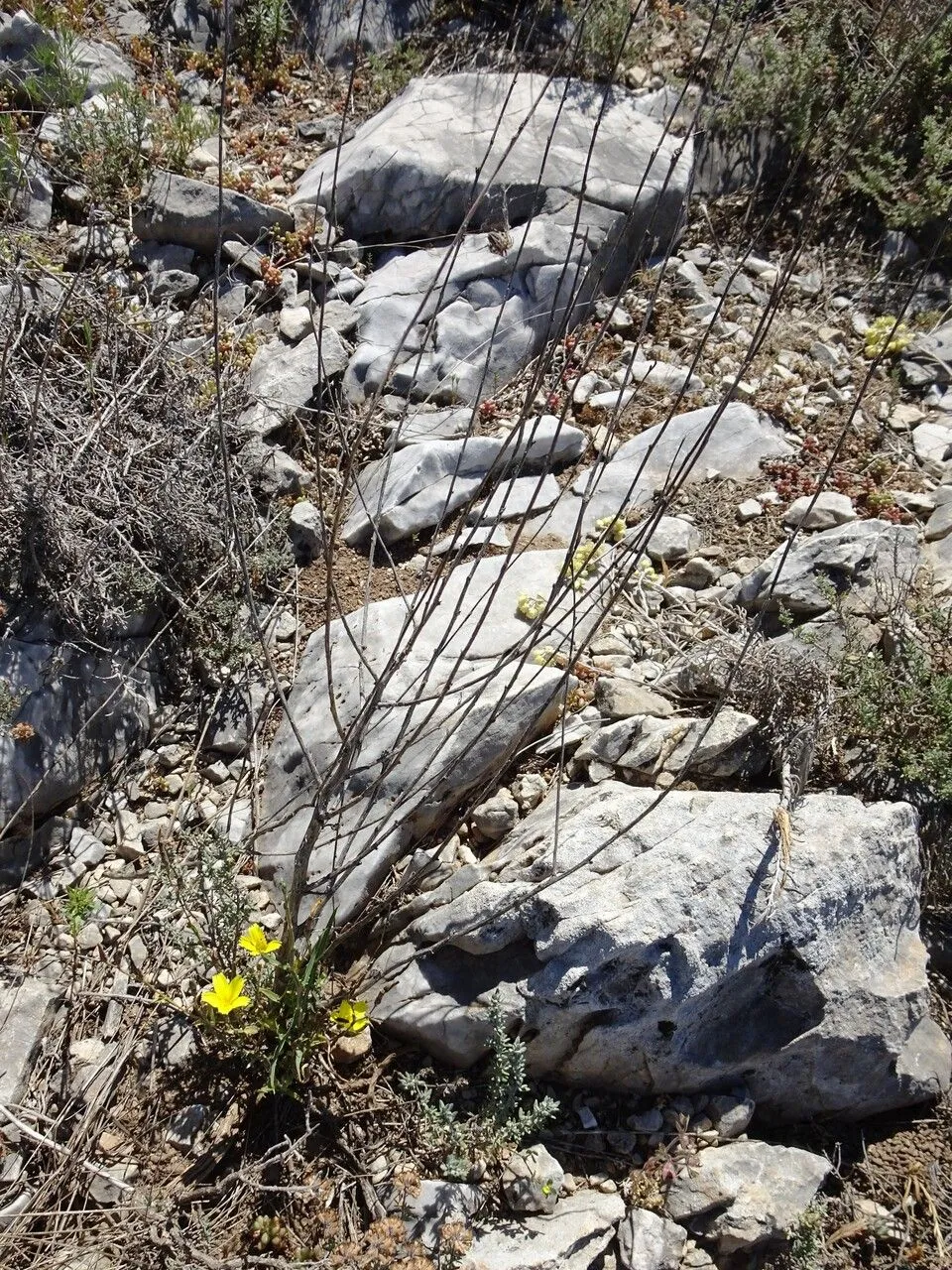
Author: (L.) J.Presl & C.Presl
Bibliography: Fl. Cech.: 160 (1819)
Year: 1819
Status: accepted
Rank: species
Genus: Lactuca
Vegetable: False
Observations: Macaronesia, Europe to W. Himalaya
Pliant lettuce, scientifically known as Lactuca viminea, is a noteworthy species belonging to the family Asteraceae. This plant boasts a widespread native range, extending from the Macaronesia region and throughout Europe, reaching as far as the western Himalayas.
Described in 1819 in the “Flora Bohemia” by brothers Jan Svatopluk Presl and Karel Bořivoj Presl, pliant lettuce has piqued the interests of botanists and plant enthusiasts alike. The species name viminea refers to its flexible, often pliant stems, which is a distinctive characteristic that gives the plant its common name.
Growing primarily in temperate regions, pliant lettuce thrives in a variety of habitats, from riverbanks and meadows to roadsides and wastelands. It is known for its resilience and adaptability to different environmental conditions. This plant features elongated, lanceolate leaves that form a rosette at the base. When in bloom, it produces small yellow flowers, typical of the Asteraceae family, arranged in a loose, branched inflorescence.
The pliant nature of its stems allows Lactuca viminea to survive in areas prone to physical disturbance, showcasing an impressive degree of plasticity and adaptability. This resilience makes it not only a fascinating subject for ecological studies but also a valuable plant for understanding strategies of survival and adaptation in fluctuating environments.
Furthermore, Lactuca viminea plays an important role in local ecosystems. It serves as a food source for various insect species, while its broad distribution and vigorous growth contribute to soil stabilization in erosion-prone areas.
While not as widely known as its cultivated relatives in the Lactuca genus, such as lettuce (Lactuca sativa), pliant lettuce nonetheless holds significant ecological and botanical importance. Its wide geographical range, adaptive strategies, and role in the ecosystem make Lactuca viminea a compelling subject for further research and study in the fields of botany and ecology.
Fra: laitue osier, laitue des vignes, laitue effilée
Ita: lattuga alata
Ces: locika prutnatá
Sqi: marule thuprore
Deu: ruten-lattich
Eng: pliant lettuce
Bul: гъвкава салата
Rus: скариола прутовидная
Hye: սկարիոլա ճիպոտանման
Heb: חַסַּת הַשְּׁבָטִים, חסת השבטים
Ara: سْكَرْيولَة سَوْحَرِيَّة
En: Pliant lettuce
Sq: Marule thuprore
Ar: سْكَرْيولَة سَوْحَرِيَّة
Hy: Սկարիոլա ճիպոտանման
Bg: Гъвкава салата
Cs: Locika prutnatá
Fr: Laitue Osier, Laitue des vignes, Laitue effilée
De: Ruten-Lattich
He: חַסַּת הַשְּׁבָטִים, חסת השבטים
It: Lattuga alata
Ru: Скариола прутовидная
Sk: Šalát prútnatý
Taken Aug 27, 2021 by Absil Luc (cc-by-sa)
Taken Oct 4, 2014 by Tela Botanica − Jean-Claude CALAIS (cc-by-sa)
Taken Sep 14, 2013 by Tela Botanica − Alain BIGOU (cc-by-sa)
Taken Sep 14, 2013 by Tela Botanica − Alain BIGOU (cc-by-sa)
Taken Jun 7, 2021 by Alain Bigou (cc-by-sa)
Taken Apr 22, 2018 by claire Felloni (cc-by-sa)
Taken Aug 30, 2019 by Daniel Bourget (cc-by-sa)
Taken Jun 7, 2021 by Alain Bigou (cc-by-sa)
Taken Jun 7, 2021 by Alain Bigou (cc-by-sa)
Taken Jul 22, 2017 by Carlos Villasante (cc-by-sa)
Taken Jul 22, 2021 by Boon Daniel (cc-by-sa)
Taken Jan 4, 2017 by Tela Botanica − Florent BECK (cc-by-sa)
Taken Sep 14, 2013 by Tela Botanica − Alain BIGOU (cc-by-sa)
Taken Sep 14, 2013 by Tela Botanica − Alain BIGOU (cc-by-sa)
Taken Jun 7, 2021 by Alain Bigou (cc-by-sa)
Taken Jan 1, 1970 by Photoflora – L’Abbé COSTE (©)
Taken Apr 27, 2008 by Tela Botanica − Daniel MATHIEU (cc-by-sa)
Taken Sep 3, 2020 by Alain Bigou (cc-by-sa)
Taken Aug 27, 2021 by Absil Luc (cc-by-sa)
Taken Oct 21, 2014 by Tela Botanica − Thierry RAVAYROL (cc-by-sa)
Taken Jul 12, 2011 by Tela Botanica − Paul FABRE (cc-by-sa)
Taken Jul 12, 2011 by Tela Botanica − Paul FABRE (cc-by-sa)
Taken Jul 23, 2019 by Tela Botanica − Claude Viquesnel (cc-by-sa)
Taken Sep 9, 2018 by Tela Botanica − Jean-Claude Bouzat (cc-by-sa)
Taken Sep 30, 2021 by Llandrich anna (cc-by-sa)
Taken Oct 20, 2019 by Tela Botanica − Sylvain Piry (cc-by-sa)
Taken Jun 27, 2022 by doune34160 (cc-by-sa)
Taken Oct 27, 2019 by Jean Burger (cc-by-sa)
Taken Oct 27, 2019 by Jean Burger (cc-by-sa)
Taken Nov 14, 2014 by Tela Botanica − Marie PORTAS (cc-by-sa)
© copyright of the Board of Trustees of the Royal Botanic Gardens, Kew.
© copyright of the Board of Trustees of the Royal Botanic Gardens, Kew.
© copyright of the Board of Trustees of the Royal Botanic Gardens, Kew.
Ph maximum: 7.5
Ph minimum: 7.0
Light: 6
Atmospheric humidity: 4
Bloom months: [‘jul’, ‘aug’, ‘sep’]
Soil nutriments: 6
Family: Myrtaceae Author: (F.Muell.) K.D.Hill & L.A.S.Johnson Bibliography: Telopea 6: 402 (1995) Year: 1995 Status:…
Family: Rubiaceae Author: Pierre ex A.Froehner Bibliography: Notizbl. Bot. Gart. Berlin-Dahlem 1: 237 (1897) Year:…
Family: Sapindaceae Author: Koidz. Bibliography: J. Coll. Sci. Imp. Univ. Tokyo 32(1): 38 (1911) Year:…
Family: Asteraceae Author: A.Gray Bibliography: Pacif. Railr. Rep.: 107 (1857) Year: 1857 Status: accepted Rank:…
Family: Fabaceae Author: Medik. Bibliography: Vorles. Churpfälz. Phys.-Ökon. Ges. 2: 398 (1787) Year: 1787 Status:…
Family: Aspleniaceae Author: (Cav.) Alston Bibliography: Bull. Misc. Inform. Kew 1932: 309 (1932) Year: 1932…